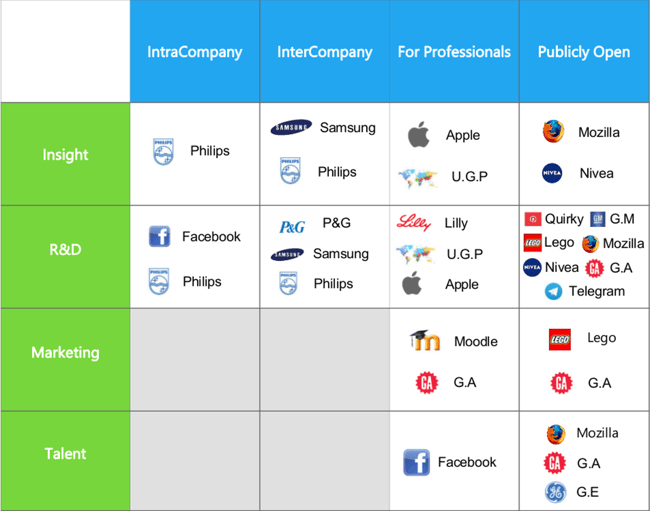Types of Open Innovation
Prospecting new ways to boost innovation has become even more important than before.
With the speed of change and the ease of communication being higher than ever, many companies are starting to abandon the stone-etched mindset of having to create everything by themselves and turning towards open innovation instead.
This post focuses on introducing different types of open innovation by using two observable dimensions: for which purpose is open innovation used for and to whom is it targeted. We then compile different ways of realizing open innovation through the cross-referencing of these dimensions and place in examples of open innovation from our earlier post. Based on the framework, we then provide guidelines for finding the right method of open innovation for your needs.
Table of contents
The Two Dimensions of Open Innovation
The first dimension, in this typology of open innovation, is the function or goal. It’s what you aim to achieve with open innovation, or better, what area of your business you aim to improve.
This dimension can be broken down into four clear segments: R&D, insight, marketing, and talent.
Research and development entails using it to develop ideas and products that are accurately tuned to match customer requirements.
“Insight” is the term we use here for the process of figuring out what those requirements actually are, based on market and customer intelligence.
Marketing entails ways of gaining a strategic competitive advantage by finding new ways to boost your brand and make your products “sell themselves”.
Talent scouting means finding ways to connect with unique talent that is usually hard to reach and evoking their interest in working with you.
The second dimension is the target audience, which is here arranged by the level of transparency. It is the group of people you aim to address with open innovation and can vary drastically depending on shared information sensitivity and the required level of knowledge to supply valuable information. This dimension can be broken down into four segments: intracompany, intercompany, publicly open and for professionals.
Intracompany means that information and collaboration is shared only internally between the employees of one company. Strictly speaking, this might not count as open innovation, but we’d still like to include it here as it behaves very much like open innovation in the case of most large organizations. An example of this could be a hackathon: intensive engagement of joint multi-disciplinary effort to solve acute business challenges.
Intercompany means that information is shared between several collaborative partner companies, often working on a common field of operation. The point is to form symbiotic relationships where all participants can reap the benefits of united strength without “stepping on each other’s toes.” This usually works well when the companies specialize on delivering value in different parts of the supply chain.
Publicly open is the most common form of open innovation, as the name would suggest. It means using every individual, who is willing to contribute, to get input on what aspects of the product consumers find important. You can utilize almost any channel available to reach out to the masses, be it to help improve your products, or finding new talent to work with you.
In some cases, it is important to target a very specific group of professionals. Although targeting the entire public may spark a wider range of ideas, in some cases, the participants must have an advanced understanding of the field to be able to really contribute. For example, a company developing cutting edge drugs would usually need the help of individuals educated in medicine. For this reason, universities are often a common target audience when seeking for fresh ideas of professional quality.
Cross-referencing the Dimensions
When cross-referencing these dimensions, we are left with 12 different types of combinations. Although most open innovation examples fall into one category or several, some may be impossible to categorize with just these dimensions. Thus, it is important to remember that this is only one method of segmenting open innovation. The following table presents how all 16 cases from our earlier listing fit the framework.

As we can see from this illustration, publicly open appears to be the most popular type of open innovation, but this might be due to a systematic bias in the collection of observations. Finding closed cases of open innovation is significantly harder than public due to their nature. Variances in terminology may also falsify results, since open innovation as a term is sometimes only used to refer to publicly open R&D. Ultimately, finding the right way to implement open innovation is always dependent on your goals and industry specific requirements.
The definition of Insight doesn’t really vary from category to category. It means the background research you do to gain valuable insight regarding your market and customers. For example, publicly open customer surveys to find out what key elements should be improved by the R&D unit. As such, insight is highly linked to R&D.
IntraCompany R&D can be used if secrecy is an especially important factor. As it is, for example, in technology firms, where intellectual property rights can become an issue. It’s also a viable course of action when the ways of executing R&D are very company specific and monitored, thus making collaboration with an outside source difficult.
InterCompany R&D is a very useful method of utilizing open innovation when faced with prospects of symbiotic business-relationships. Professional R&D is common for situations where the prerequisites required to contribute are high, as is often the case in many fields such as medicine and programming.
Publicly open R&D is a versatile method due to the benefits of exponential scale; focusing on quantity to ensure quality. It is especially beneficial when the R&D process doesn’t require expertise, but rather original ideas or collective consumer knowledge. It may also work as a hybrid with, for example, IntraCompany R&D, where the research could be done openly and development internally.
The mission in professional or publicly open marketing, is to evoke legitimate interest in the product, resulting in an increase in brand perception and awareness. It is about getting people to buy in on what you’re trying to accomplish and in what you have to offer. In that sense, it’s a more of a tool for strategic marketing, than a single tactic. For that reason, this approach requires a very holistic approach to embracing transparency and openness to succeed.
Professional talent scouting can be done by gathering ambitious professionals together to work on challenges they love to solve. For example, Facebook does this by organizing theme specific hackathons for certain groups of professionals in pursuit of discovering new talent. For example, female hackathons where women get together to program and develop anything from software to phone apps. The same method could be applied for Intracompany talent scouting.
Publicly open talent scouting is a good way to appeal to professionals in all fields. It’s about making yourself visible to the crowd by organizing different competitions and events, with the end goal of finding and screening highly talented and motivated experts. Someone who shows promising skill in an event that is custom-made to find valuable prospects, likely has the necessary skill set to continue contributing as an employee.
The several boxes that are left barren are only useful under very specific circumstances. Next, we will take a look at a few steps that might help you get started with open innovation.

Getting Started With Open Innovation
Open innovation isn't rocket science but it is such a vast field that getting started might feel overwhelming. To systematically approach open innovation, try breaking it down into smaller steps. This way, you'll eventually close in on the methods that best suit your business. An example of a systematic approach to open innovation could be:
- Picking your goals
- Choosing the appropriate audience
- Planning and executing strategic pilots
- Evaluating the next steps
Goals
Picking your goals is an important step to start off the process as it underlines what you aim to achieve and whether open innovation is a plausible tool to achieve it with. Find out what things you ultimately wish to accomplish, prioritize them, and then reassess whether open innovation could help get you there. Just as most tools, open innovation is only useful if used for the right job. Using open innovation for the sake of open innovation would be rather pointless.
Audience
After you have a clear image of achievable prioritized goals, the next step is to figure out the right target audience to achieve it with. You can achieve that by asking yourself who the people that best know the topic are and where to find them.
For example, targeting software developers through a publicly open audience might not be very effective, whereas that same audience could be exactly what you need if you want to reach the whole spectrum of users for a consumer product, such as a deodorant. While more is better, finding a good audience is first and foremost about targeting the right people, even if that means just a few people.
Pilot
Open innovation, by definition, has a lot variables involved and is thus very difficult to plan. Getting it right usually takes several attempts so don’t focus too much on being perfect the first time around, but rather on keeping the pilot as simple as possible while still effectively addressing the questions most important for you. Ultimately, the point of this step is to be able to ensure that your goals and the audience are aligned.
When running a pilot, you’ll often unearth issues you never thought of beforehand, and can also quickly validate that the basic approach works as intended. After the experience of running a pilot, it’s easy to see how you should improve your previous work, or even discard it entirely if deemed impractical.
Ensuring Continuity
The point of repeating this process, is to fast-track you towards your end goals. Working the process from this angle also enables the possibility of repeating the steps as new goals emerge, potentially realizing those goals through open innovation. It works best when you focus both on piloting new approaches and still continuously improving the existing ones to the point where it's no longer cost-efficient to continue due to diminishing marginal benefits. If you embrace the approach, it can be a never-ending process with an abundance of benefits to reap.
Final Thoughts
Open innovation can be an extremely useful tool if used for the right job. It has vast potential, ready to be harnessed, as shown by many exemplary cases. Although, keep in mind, these are only the success stories. Open innovation is, by definition, a very complex field with a high degree of unpredictability involved, which means that you might need to rethink some of your current ways of working to be able to apply it successfully.
Good results tend to follow a systematically executed process of continuous improvement. A process that reveals early on whether open innovation is the right tool to ultimately help you reach your goals, or at least a part of them. Remember that you can, and usually should, use open innovation in conjunction with other, more traditional, methods.
If you want to get started with open innovation, we've created a dedicated board templated in Viima, where you can start collecting ideas.
The open innovation board templated was specifically designed to manage your open innovation initiatives in a user-friendly, intuitive and efficient manner. You can start collecting and developing the most promising ideas right away!
This post is a part of our Open Innovation blog-series. In this series, we dive deep into the different areas of open innovation and cover the aspects we think are the most important to understand about open innovation.








